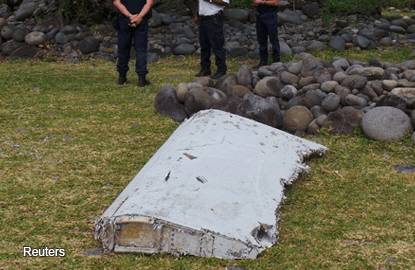
(Aug 7): The discovery of a Boeing 777 wing part on a remote Indian Ocean island was a "real boost" to experts scouring treacherous seas for the missing MH370, Australia's search chief said today.
The Malaysia Airlines passenger jet vanished on March 8 last year en route from Kuala Lumpur to Beijing with 239 people on board, and its disappearance remains one of aviation's great mysteries.
A wing part, called a flaperon, washed up on the French territory of Reunion island last week, and experts believe it possible that the wreckage could have been carried there from the current search site.
Prime Minister Datuk Seri Najib Razak has "conclusively confirmed" the flaperon was from MH370, while French prosecutors and the Australian government have been more cautious in declaring a definite connection.
But Martin Dolan, chief commissioner of the Australian Transport Safety Bureau (ATSB), the agency leading the search, said that the ATSB was working on the assumption that the wing part was linked to MH370.
"It gave a real boost to the teams that are out there searching and our people in Canberra and Perth," the search chief told AFP of the find.
"It's a reinforcement that we are doing the right thing. As you know, they are a very committed team, but this gave them a real boost and they remained really focused on finding that missing aircraft."
After reviewing their data – including the use of drift modelling to map out where debris might have floated – Dolan said the team was confident the current search zone, about 4,000m from Reunion island where the 2m-long piece was found, was correct.
The site of the probe – jointly funded by Australia and Malaysia with a budget of more than A$100 million (RM290 million) – is so remote that it takes the ships up to six days to reach it from the Australian port of Fremantle where they routinely refuel and restock.
While there has been hope that examination of the flaperon could yield some insights into how the plane might have entered the water, Dolan said any analysis would not change the debris search.
"We didn't need to take account of how the plane might have hit the water. That really only affects the quantity of debris," Dolan said, adding that even in scenarios where a plane had a very hard entry into the water, its engines would "remain largely intact".
"The more likely case – that it landed a bit less hard than that – there's going to be large pieces of the airframe intact so they are easier to detect with the techniques we're using," he said. – AFP